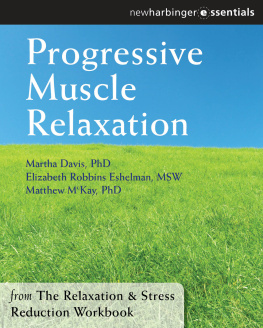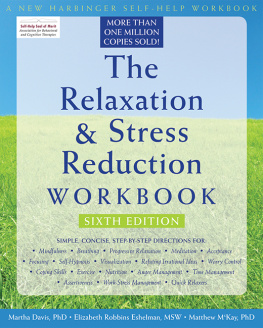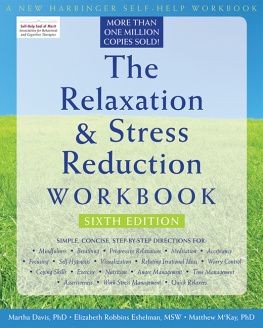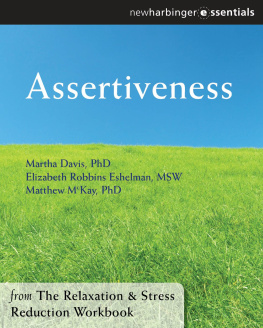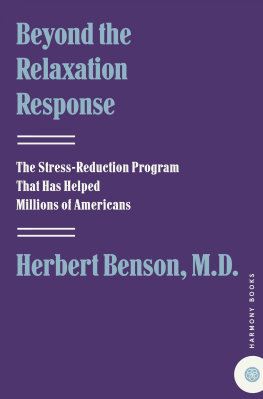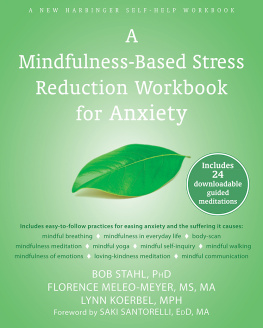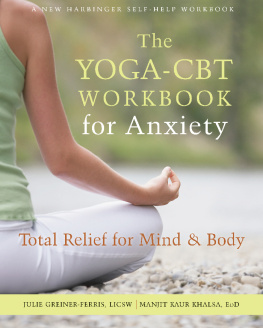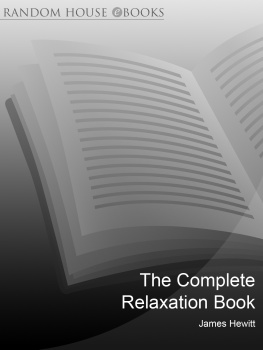Publishers Note
This publication is designed to provide accurate and authoritative information in regard to the subject matter covered. It is sold with the understanding that the publisher is not engaged in rendering psychological, financial, legal, or other professional services. If expert assistance or counseling is needed, the services of a competent professional should be sought.
The material in chapter 13 that is based upon the work of Michelle G. Craske and David H. Barlows Master Your Anxiety and Worry, 2nd ed. (2006) pages 99109 is used by permission of Oxford University Press.
Distributed in Canada by Raincoast Books
Copyright 2008 by Martha Davis, Elizabeth Robbins Eshelman, and Matthew McKay
New Harbinger Publications, Inc.
5674 Shattuck Avenue
Oakland, CA 94609
www.newharbinger.com
All Rights Reserved
ePub ISBN: 9781608820702
Acquired by Tesilya Hanauer; Cover design by Amy Shoup;
Edited by Kayla Sussell
The Library of Congress has cataloged the print edition as:
Davis, Martha, 1947
The relaxation and stress reduction workbook / Martha Davis, Elizabeth Robbins Eshelman, and Matthew McKay. -- 6th ed.
p. cm.
Includes bibliographical references and index.
ISBN-13: 978-1-57224-549-5 (pbk. : alk. paper)
ISBN-10: 1-57224-549-2 (pbk. : alk. paper) 1. Stress management. 2. Relaxation. I. Eshelman, Elizabeth Robbins. II. McKay, Matthew. III. Title.
RA785.D374 2008
616.98--dc22
2008003637

Praise for The Relxation and Stress Reduction Workbook:
This comprehensive workbook deserves to be in the library of every active therapist, but it shouldnt be left on the shelf! Once again, the authors have empowered the reader with straightforward instructions on every major approach to stress management known. From worry to chronic headaches to information overload, here is your one-stop guide to recovery.
R. Reid Wilson, Ph.D., author of Dont Panic: Taking Control of Anxiety Attacks
This text remains, after twenty years, the clearest, best-organized, and most readable book on stress management. It has achieved the status of the classic self-help reference in the field.
Edmund J. Bourne, Ph.D., author of The Anxiety and Phobia Workbook, Coping with Anxiety, and Beyond Anxiety and Phobia
An exemplary book on stress. It is lucidly written, rationally ordered, and comprehensive, and each section is densely packed with instructions and exercises which make the workbook easy to practice.
Somatics Magazine: Journal of the Mind/Body Arts and Sciences

Progressive Muscle Relaxation
In this chapter you will learn to:
- Distinguish between tense and relaxed muscles
- Progressively relax all of the muscles of your body
- Relax quickly in stressful situations
Background
You cannot have the feeling of warm well-being in your body and at the same time experience psychological stress. Progressive relaxation of your muscles reduces pulse rate, blood pressure, and the startle reflex, as well as reducing perspiration and respiration rates. Deep muscle relaxation, when successfully mastered, can be used as an antianxiety pill.
Edmund Jacobson, a Chicago physician, published the book Progressive Relaxation in 1929. In it he described his deep muscle relaxation technique, which he asserted required no imagination, willpower, or suggestion. His technique is based on the premise that the body responds to anxiety-provoking thoughts and events with muscle tension. This physiological tension, in turn, increases the subjective experience of anxiety. Deep muscle relaxation reduces physiological tension and is incompatible with anxiety: The habit of responding with one blocks the habit of responding with the other.
Jacobsons original progressive relaxation procedures might take many months or even years to learn, but Joseph Wolpe (1958) developed a short form for these procedures that included verbal suggestions to relax. This abbreviated form can be mastered in a matter of days or weeks. Wolpe made this streamlined version a part of his systematic desensitization protocol for the treatment of phobias. He found that once they relaxed, clients were more capable of tolerating and responding adaptively to situations they were afraid of.
Symptom-Relief Effectiveness
Excellent results have been found with progressive relaxation techniques for the treatment of muscular tension, anxiety, depression, fatigue, insomnia, neck and back pain, high blood pressure, mild phobias, and stuttering.
Time to Master
One to two weeks, employing two fifteen-minute sessions per day.
Instructions
Many people do not know which of their muscles are chronically tense. When you practice progressive relaxation, you focus on the sensations of tension in one particular muscle group at a time. Then, when you release that tension, you focus on the sensations of relaxation in that same muscle group. You move progressively through your whole body from one muscle group to the next, repeating this procedure. Using progressive relaxation techniques, you learn to identify particular muscle groups and to distinguish between the sensations of tension and deep relaxation.
Progressive relaxation can be practiced lying down or seated in a chair. Each muscle group is tensed from five to seven seconds and then released and relaxed for twenty to thirty seconds. These lengths of time are simply rules of thumb and dont have to be slavishly adhered to. This procedure is repeated at least once. If a particular muscle is difficult to relax, you can practice tensing and releasing it up to five times.
Once the procedure is familiar enough to be remembered, keep your eyes closed and focus your attention on just one muscle group at a time. Another option is to purchase a professional recording such as the one listed in the Recording section at the end of this ebook.
The instructions for progressive relaxation are divided into two sections. The first part deals with the basic procedure, which you may wish to record and replay while practicing. This will familiarize you with the muscles in your body that are most commonly tense. If you do record these instructions, be sure to pause long enough for tensing and relaxing. The second section shortens the procedure by simultaneously tensing and relaxing many muscles at one time, so that deep muscle relaxation can be achieved in a very brief time period.
The Three Basic Levels of Tensing
There are three basic levels of tensing that you can use when you practice progressive relaxation. With experience, you can decide which level of tensing is most pleasant and effective for your needs.
- Active tensing involves tensing a particular muscle group as tightly as you can without hurting yourself, studying the sensations of tension, then releasing the tension and studying the sensations of relaxation in that same area. While you are tensing one part of your body, the rest of your body is relatively relaxed. Remember to breathe diaphragmatically (its easy to forget to breathe this way, especially during the tensing phase). Active tensing is the level of progressive relaxation described in italics below. By really exaggerating the tension, you are likely to feel where you carry chronic tension; the tense place may actually be sore. For people who have no injuries and who are not extremely tense, active tensing is recommended as the method of choice, at least for the first time you practice progressive relaxation. Some people prefer using this level every time they practice progressive relaxation, because tensing the muscles fatigues the muscle fibers and releasing the tension feels very relaxing and good. Its a little like setting down heavy bags youve been holding while standing in a long line.

